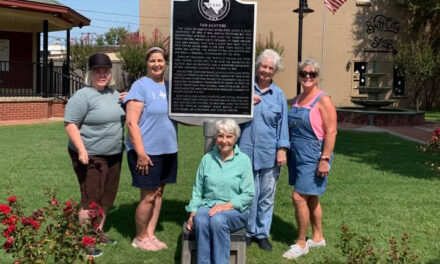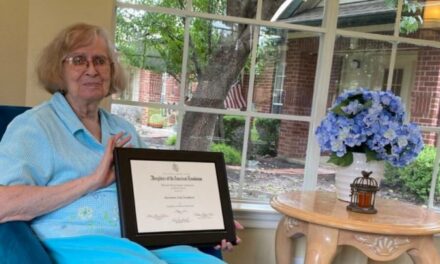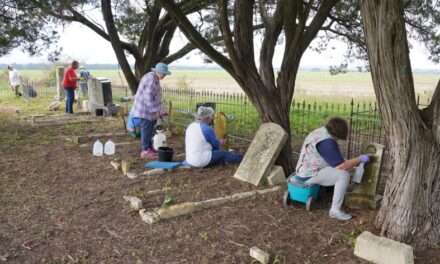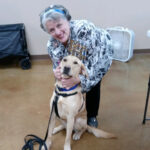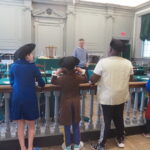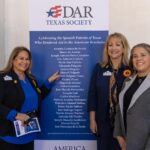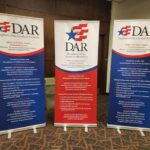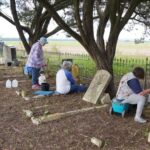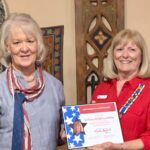The Texas Society Daughters of the American Revolution dedicated the first America 250! plaque in Texas during a special ceremony on November 12, 2022, at the Spanish Governor’s Palace in San Antonio, Texas. Many honored guests were present, including NSDAR President General Pamela Edwards Rouse Wright; Honorary President General Lynn Forney Young, who serves on the U.S. Semiquincentennial Commission; Historian General Suzanne Heske; National America 250! Chair Kathryn Walker West; the Honorary Consul of Spain, the Honorable Steve Alfonso Chiscano; and leaders from several Hispanic Heritage societies.
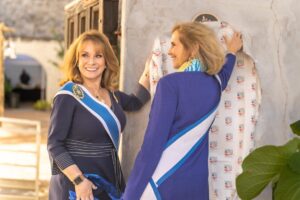 TXDAR worked closely with the City of San Antonio’s World Heritage Office to place this plaque at the Spanish Governor’s Palace in recognition of the essential contributions made by Spanish ranchers in the quest for American independence. These ranchers are among the more than 500 Spanish Patriots to whom DAR members have traced their lineage.
TXDAR worked closely with the City of San Antonio’s World Heritage Office to place this plaque at the Spanish Governor’s Palace in recognition of the essential contributions made by Spanish ranchers in the quest for American independence. These ranchers are among the more than 500 Spanish Patriots to whom DAR members have traced their lineage.
After Spain declared war on Britain as an ally of France, Spanish forces, under the leadership of the Spanish Governor of Louisiana, General Bernardo de Gálvez, attacked British positions in the south and captured West Florida during battles along the Gulf Coast, ending with the Siege of Pensacola. Pensacola’s battle lasted for two months, ending May 8, 1781, making it the longest-lasting siege of the American Revolution. This secured the southern route for supplies and closed off the possibility of any British offensive through the western frontier of the United States via the Mississippi River.
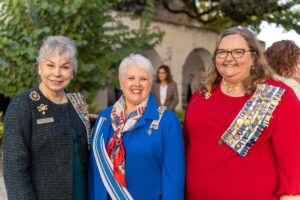 Spain also supported American forces with money, food supplies, uniforms, blankets, medicines, weapons, and munitions. In 1780, Carlos III, the King of Spain, issued a royal decree that all subjects in Nueva España make a voluntary contribution, or donativo, of one or two pesos to help fund the American Revolution. In 1781, Spain provided financing for the Battle of Yorktown with gold and silver coins collected in Havana, alleviating the financial difficulties faced by General George Washington and the Continental Army. Spain also financed French land and naval forces critical to the American war effort and ultimate victory at Yorktown.
Spain also supported American forces with money, food supplies, uniforms, blankets, medicines, weapons, and munitions. In 1780, Carlos III, the King of Spain, issued a royal decree that all subjects in Nueva España make a voluntary contribution, or donativo, of one or two pesos to help fund the American Revolution. In 1781, Spain provided financing for the Battle of Yorktown with gold and silver coins collected in Havana, alleviating the financial difficulties faced by General George Washington and the Continental Army. Spain also financed French land and naval forces critical to the American war effort and ultimate victory at Yorktown.
In Texas, Spanish ranching activity had reaching “astonishing proportions” in the 1770s and 1780s, as documented by the Honorable Robert H. Thonhoff in his book The Texas Connection with the American Revolution. The area now occupied by present-day San Antonio was home to the Presidio de San Antonio de Béxar, which included the Spanish Governor’s Palace, residence of the presidio’s senior ranking officer. Around the presidio was the Villa de San Fernando de Béxar, founded in 1731 by the Canary Islanders sent by Spain’s King Felipe V to establish the first civil government in the Province of Texas.
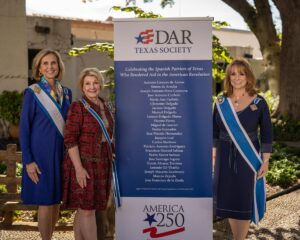 In 1779, Gálvez—in need of supplies for his forces in Louisiana—sent an emissary, Francisco Garcia, requesting and authorizing the first cattle drive out of Texas. Garcia arrived in San Antonio de Béxar on June 20, 1779. By August 1779, 2,000 head of Texas cattle from the Spanish ranches located along the San Antonio River Valley and the La Bahia area (now Goliad) were headed to Gálvez’s forces. All told, more than 9,000 head of cattle were trailed from Texas to Louisiana between 1779 and 1782 in support of Spanish troops and local militias.
In 1779, Gálvez—in need of supplies for his forces in Louisiana—sent an emissary, Francisco Garcia, requesting and authorizing the first cattle drive out of Texas. Garcia arrived in San Antonio de Béxar on June 20, 1779. By August 1779, 2,000 head of Texas cattle from the Spanish ranches located along the San Antonio River Valley and the La Bahia area (now Goliad) were headed to Gálvez’s forces. All told, more than 9,000 head of cattle were trailed from Texas to Louisiana between 1779 and 1782 in support of Spanish troops and local militias.
A National Historic Landmark, the Governor’s Palace represents the last visual remnants of the Presidio San Antonio de Béxar, making it the ideal location for a DAR America 250 marker. The America 250! marker is located in the side courtyard of the Governor’s Palace and is visible from Commerce Street. Following the dedication ceremony, guests enjoyed a reception hosted by the 12 chapters of the San Antonio Area Regents Council, as well as the Thomas Shelton and Uvalde de las Encinas chapters.

